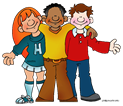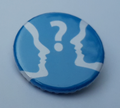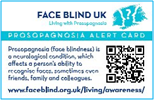The danger of appearing rude or seeming not to value a relationship means that people often cover up the fact that they don’t recognise the other person. In fact many people are unaware that they have face blindness, usually being unaware that it exists as a specific neurological condition.
People with prosopagnosia are likely to have found a number of different ways of coping with social situations. In addition, as awareness of prosopagnosia is increasing more people are starting to explain their difficulties to others. A mix of the two approaches (explaining and manoeuvring) is likely to work best for most people.
Jo Livingston (Editor of ‘What It’s Like to be Face Blind’ and a Director of Face Blind UK) has put together some useful suggestions:
Give due warning When I meet anyone who I think I’m likely to come across again, I always try to throw in just a one-liner – ‘By the way, if we meet again I probably won’t recognise you – the bit of my brain that recognises faces doesn’t work’. Most people look politely disbelieving but at least if you’ve told them they can’t complain later. And sometimes they want to know more and ask you about it.
If you wear a Face Blind UK badge and explain why you’re wearing it the first time you meet, then it may act as a reminder to others when you meet them again.
Explaining to friends and strangers I’m not sure if this is typical but I find it much easier to explain to strangers or acquaintances than to people I’ve known a long time. Family and old friends have a much more fixed idea of you as a person (social incompetence and all!) and don’t like having their ideas upset. I think I’d have found it difficult to explain to my parents (they were both dead by the time I found out about it) because their generation would find the concept quite bizarre and also it could have led to an element of guilt (quite unreasonably) over not having known of it when I was growing up.
Getting help Try to get the people you’re closest to on your side, whether friends or colleagues, ask for their help in identifying others. Some friends are very helpful and identify themselves each time you meet. Even if they’re someone who you don’t usually have difficulty recognising, it’s good to have the support. (In Ancient Rome there was a post called a nomenklator, a slave whose duty was to remind his master of the names of those who greeted him. I’d love one of those).
Face Blind UK have produced a series of factsheets to help explain the condition and offer ideas as to the ways in which other people may be able to help.

Group awareness Once you start telling people, the word will spread within the larger group that talk to each other. I’d rather be known as ‘that woman who’s got something wrong with her brain – can’t remember what it’s called’ instead of ‘oh, she’s the snooty one’. Make a joke of it if you can. If you’re asked who someone is in a group just say ‘Don’t ask me!’ and they’ll realise and laugh.
Disbelief You can find that people who matter to you, like close family, or those who are significant in your life at work or in the community, refuse to believe what you’ve discovered. You can get copies of articles for them to read, find links to information and videos on the web, that may convince them that prosopagnosia is a real condition and you’re not making it up.
The Prosopagnosia Alert Card may also help give authority to what you’re saying, along with the links to publications and research centres on this website.
Name tags etc At work or in a formal situation, always encourage the use of name tags and identifications at the beginning of a meeting. Learn to scribble discreetly while that’s going on – make a note of hair, style of dress, tone of voice etc. A plan of where people sit can be useful later, especially if it’s a regular meeting – people often sit in the same place next time. In a large meeting, people can be asked to identify themselves when they speak.
Always arrive first If you’ve arranged to meet somewhere like a cafe and let the other person find you. You can be lost in a book or the view while they do the difficult bit.
Asking the name This works well in a slightly formal or crowded situation or with children or teenagers. You ask their name, they tell you, in a slightly huffy way, that ‘it’s Sharon, innit’ and you say ‘Yes, of course I know that but it’s your surname I can’t remember’. I found this invaluable when I was teaching but of course it won’t help if it turns out to be your sister!

Using other people’s names You probably don’t do this if you can avoid it – I always felt very uncomfortable saying people’s names, with no idea why. Now I know it’s just too risky – you can bluff all you like but once you’ve got their name wrong there’s no going back.
In a crowd Noticing what someone is wearing on a particular day or the way they have their hair or the bag that they’re carrying, can help to re-find the person you’re with amongst all the other shoppers in a store or people in a pub.
Record keeping Make notes (written down if it helps) about all the things you use to recognise an individual – hair, both style and colour, beards, glasses, ear-rings, body shape, piercings, tattoos, birthmarks. These tactics aren’t infallible (hairstyles may change, beards get shaved off etc.) but they often work, especially once you learn to do it as a deliberate exercise and it becomes automatic. If necessary, keep your notes in code, it depends how personal it gets!
If you have any coping strategies you’d like to share with others, send them to us using the form below :


